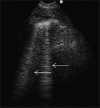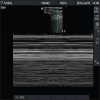Intraoperative lung ultrasound: A clinicodynamic perspective
- PMID: 27625474
- PMCID: PMC5009832
- DOI: 10.4103/0970-9185.188824
Intraoperative lung ultrasound: A clinicodynamic perspective
Abstract
In the era of evidence-based medicine, ultrasonography has emerged as an important and indispensable tool in clinical practice in various specialties including critical care. Lung ultrasound (LUS) has a wide potential in various surgical and clinical situations for timely and easy detection of an impending crisis such as pulmonary edema, endobronchial tube migration, pneumothorax, atelectasis, pleural effusion, and various other causes of desaturation before it clinically ensues to critical level. Although ultrasonography is frequently used in nerve blocks, airway handling, and vascular access, LUS for routine intraoperative monitoring and in crisis management still necessitates recognition. After reviewing the various articles regarding the use of LUS in critical care, we found, that LUS can be used in various intraoperative circumstances similar to Intensive Care Unit with some limitations. Except for few attempts in the intraoperative detection of pneumothorax, LUS is hardly used but has wider perspective for routine and crisis management in real-time. If anesthesiologists add LUS in their routine monitoring armamentarium, it can assist to move a step ahead in the dynamic management of critically ill and high-risk patients.
Keywords: Alveolar interstitial syndrome; atelectasis; intraoperative desaturation; lung ultrasound; pneumothorax.
Figures










References
-
- Buzzas GR, Kern SJ, Smith RS, Harrison PB, Helmer SD, Reed JA. A comparison of sonographic examinations for trauma performed by surgeons and radiologists. J Trauma. 1998;44:604–6. - PubMed
-
- Smith RS, Kern SJ, Fry WR, Helmer SD. Institutional learning curve of surgeon-performed trauma ultrasound. Arch Surg. 1998;133:530–5. - PubMed
-
- Lichtenstein D, Goldstein I, Mourgeon E, Cluzel P, Grenier P, Rouby JJ. Comparative diagnostic performances of auscultation, chest radiography, and lung ultrasonography in acute respiratory distress syndrome. Anesthesiology. 2004;100:9–15. - PubMed
-
- Greenbaum DM, Marschall KE. The value of routine daily chest x-rays in intubated patients in the medical intensive care unit. Crit Care Med. 1982;10:29–30. - PubMed
-
- Janower ML, Jennas-Nocera Z, Mukai J. Utility and efficacy of portable chest radiographs. AJR Am J Roentgenol. 1984;142:265–7. - PubMed
Publication types
LinkOut - more resources
Full Text Sources
Other Literature Sources

